Mr. Robot Season 2 and The Prisoner
- 8 minutes read - 1553 wordsSpoilers: Discussion of “Mr. Robot” Seasons 1 and 2, including finale. “The Prisoner” including finale.
Introduction
“Mr. Robot’s” second season (which ended this week) marked a departure in narrative from the first season that left some viewers confused and possibly disappointed. While Eliot’s psychology has always been a key element in the show, this season marked a shift from the “hacker heist” episodic narrative structure into a psychological examination of many of the core characters. This move, within the context of network television, is surprising, non-traditional and subversive; it’s bravery may serve to make “Mr. Robot” timeless. I’d like to look at how this narrative shift recalls another pioneering television program, ITV’s “The Prisoner” which did something similar.
“The Prisoner”
“The Prisoner” instantly makes a deep impression. Much like the first time you hear The Doors’ “The End” or watch Ponnelle’s presentation of “O Fortuna”, you’ll never forget it. It taps not only into good storytelling but to something out of the Collective Unconscious: something abstract, universal, and deeply unsettling.
When I first came across it, in the pre-YouTube era, it was in newsprint in an article in the “New York Times” called: “After 34 Years, Unable to Let Go Of ‘The Prisoner.’ (Read [the original][article])” Atop the full-page article was this scene from “Free for All:”
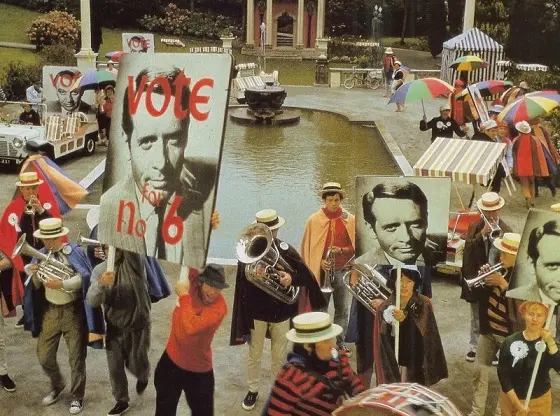
No, I’d definitely never seen anything like that before: a ruly mob in colorful clothing in an oddly Rococo-hodgepodge English garden with campaign signs and a never-before-seen typeface (“Albertus”). What was going on there?

The introduction tells us most of what we need to know. The spy, whom we later identify as “Number Six,” tenders his resignation. His handlers, fearing he may have turned and unwilling to set him free without a full accounting of his motives, imprison him in a postmodern inescapable prison whose name “The Village” covers the depth of incarceration banally afoot. His warders, and their chief, “Number Two,” assure Six (and us) that “by hook or by crook” they will extract his motives. His rebellious refusal (“I am a free man!”) drives our identification with this hero.
What follows is nearly two-dozen episodes in which reality itself is manipulated around Number 6 in order to get him to divulge his own mind. In this, the show is a reverse of “Mr. Robot,” the hero has the secret that the corrupt want to “hack” out of him by manipulating reality (e.g. adding psychoactives to his water supply).
The audience during the original airing in the late Sixties was on board with this Cold War paranoia-fueled battle between Our Hero and The State. But halfway through the work, the targets of the potshots changed: turning to religion, education, parenthood, body identity, and then ultimately to oneself. The viewers of that time were ready to see Communism against the pillory but not all of modern society.
Aside: It reminds me of seeing “Book of Mormon:” everyone’s down for a good mockery of the Mormons, but when “Mormon” is insufficiently focused and winds up hitting all religion with splatter damage, feelings get hurt and we see seats fold up and unprepared attendees walk out.
As Six’s quest to understand the power of Number Two and to discern the identity of the warder-in-chief, Number One, continues, the screen presentation grows ever more fantastic to show that we’ve moved out of the space of conventional narrative inhabited since the Odyssey to a more Lynchian / Jungian / Freudian tableau.
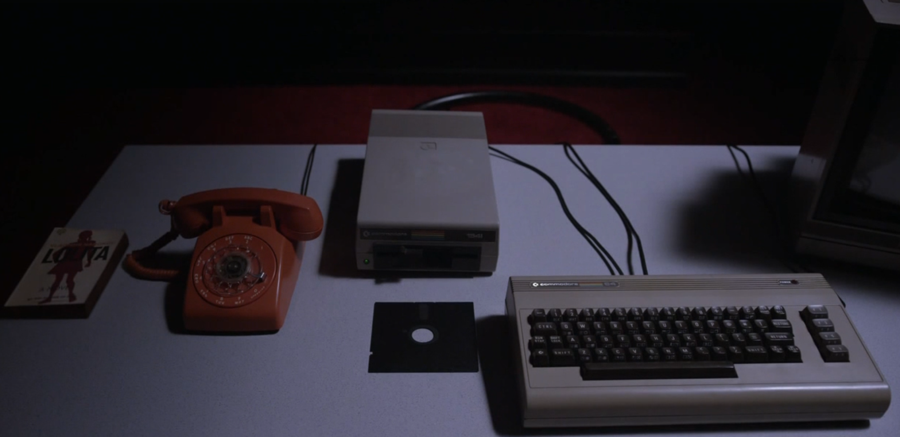
Mr. Robot Season II
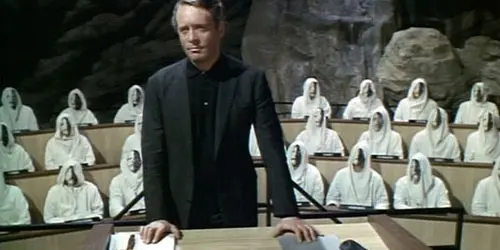
The Prisoner’s Trial Scene
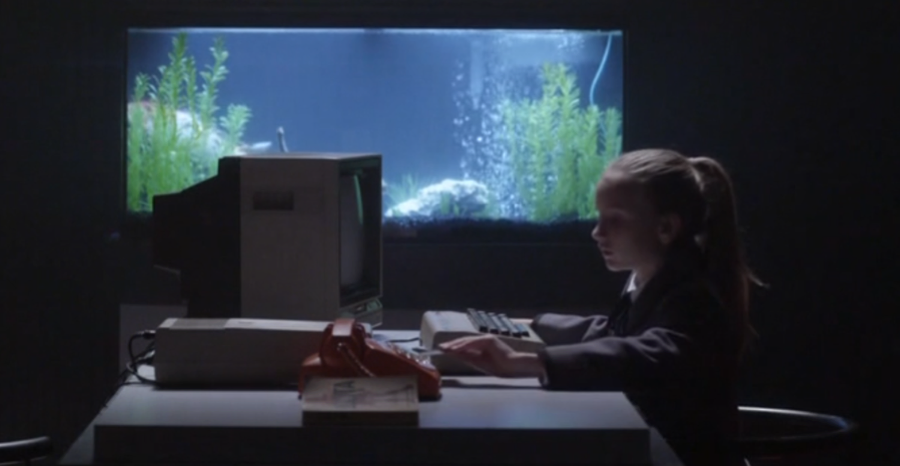
Mr. Robot: Angela’s Interview (by a co-prisoner child)
For those expecting to see Number Six turn a chair and then pop Number One in the mouth, “The Prisoner’s” finale “Fall Out” is a bitter disappointment. Six discovers that he is Number One, or perhaps a crazed monkey version of himself, or perhaps it’s a symbol of his own animal nature. Whatever it is, it’s not Dastardly Do-Wrong with a handlebar moustache or a corrupt governmental functionary getting a comeuppance. Instead the final episode features a Carnaby street Dandy, a rocket ship, a dwarf in a swallowtail jacket, “All You Need Is Love,” and a complete narrative jump.
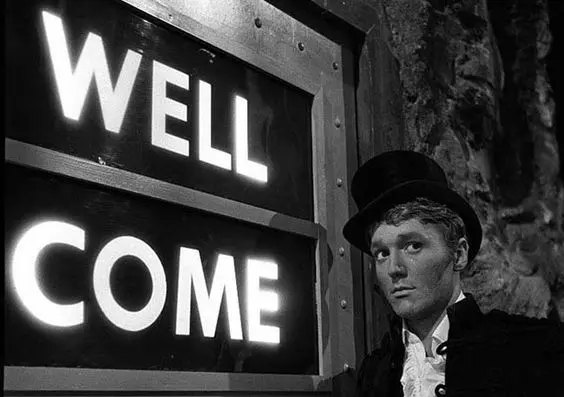
Nameless Dandy from “The Prisoner”
When “The Prisoner” aired in the late Sixties, it was not uncommon to find many fans up in arms and downright angry at McGoohan, both actor, writer, and occasionally director, for this narrative frame leap. McGoohan never revealed any secret clues and if there was a message he wished “The Prisoner” to have, he took it with him to his grave in 2009. When pressed, he would assert that everything he meant to say, he had said in the work itself.
I thought of this progression in style of storytelling often as I watched Seasons 1 and 2 of “Mr. Robot.”
“Mr. Robot”
I had seen a number of the “Mr. Robot” posters about in subway stations last Summer and Fall but hadn’t paid much attention to the show because, to be honest, since they stopped playing the “Cartoon Express” and “Double Trouble,” I hadn’t really though much of the quality of USA network programming.

Not quite the Sagal twins, but…
But my friend Alex talked about it and several tweets by Marc Andreesen convinced me to give it a go. Boy was I glad.
The central plot conceit was simple enough: an Anonymous-like collective at Coney Island planned the ultimate hack: one that would scramble the data assets of the most powerful company of the day (Like Wal-Mart + Bank of America) and “release” the 99% from life under their boot-heel (similar to the grand prize of “Project Mayhem” in “Fight Club”).
The orchestrator of this plot, and our humble narrator is Eliot (Rami Malek, who recently won an Emmy for this turn) who tells us in the very first episode that he’s an unreliable narrator. His visual and auditory apprehension of the world, that we experience, is not to be trusted. In fact, Evil Corp has a real name but Eliot only experiences their moniker as Evil Corp or E-Corp.
Nevertheless, as Season 1 plays out, it follows a conventional arc: a hacker collective called fsociety, lead by a mysterious character called “Mr. Robot,” recruits Eliot and they together they pull off a grand series of technical escapades that get them and their malware payloads inside E-Corp…and it works.

Mr. Robot himself
Evil corp’s records are encrypted and thus rendered unusable and we get celebration. And we get it, but the trouble is, who picks up the garbage on the day after the revolution?
Oh, and Eliot realizes that Mr. Robot is a figment of his imagination, a split personality Eliot assumes and whose dealings are inaccessible to our disturbed narrator.
“Mr. Robot” Season 2
“Mr. Robot” season 2 opens up as Eliot removes himself from society to battle for control of his faculties against Mr. Robot. Society continues to decay without the corporate Moby Dick of E-Corp providing its goods and services. Meanwhile fsociety realizes that it may have been played by someone else and searches for a raison d’etre now that its targets aren’t as big and obvious. It becomes clear that E-Corp was an obvious head of the hydra. The System wants control restored and, having lost a head, the other heads are more dangerous and more unpredictable.
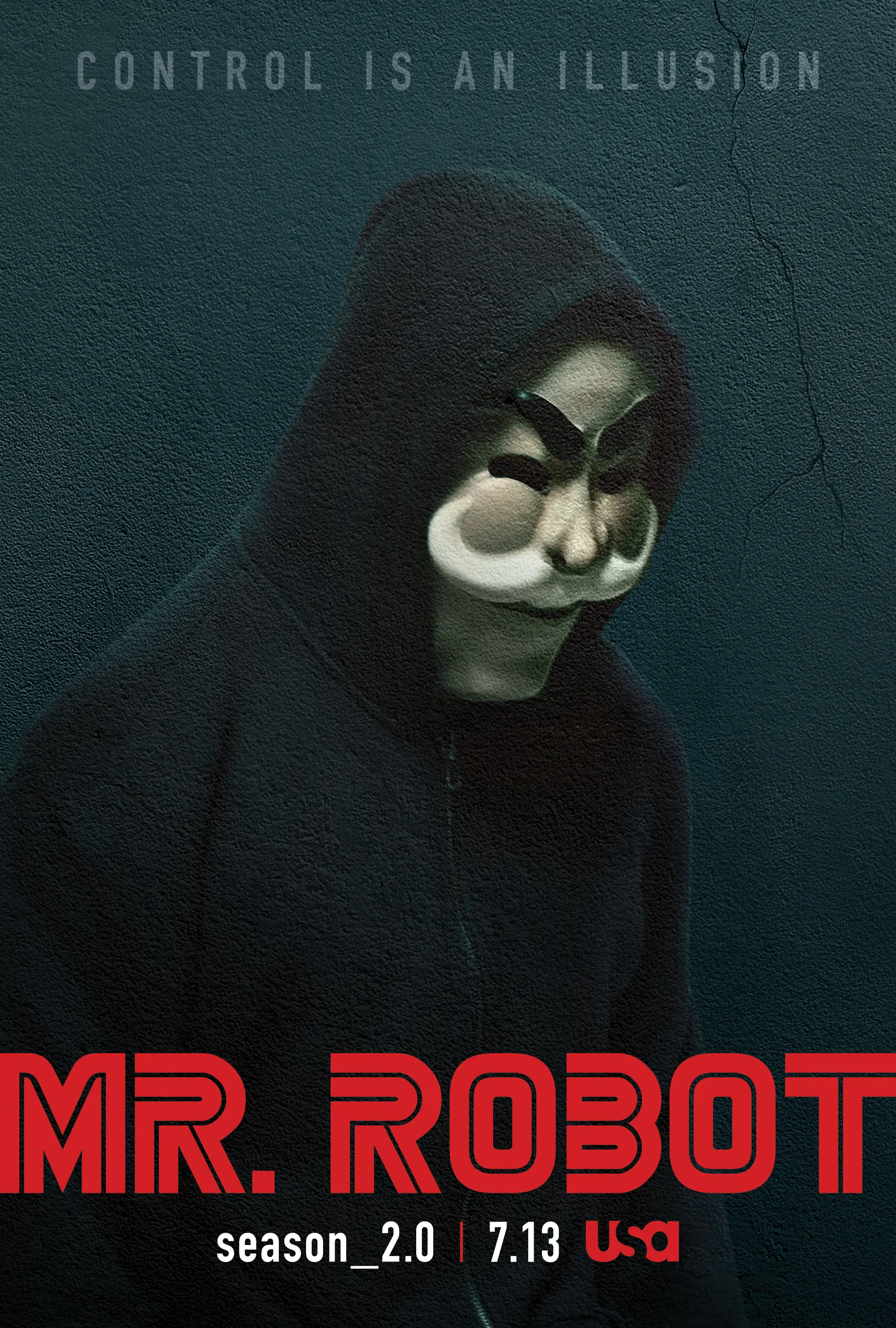
And it’s not only Eliot who’s battle becomes the personal and psychological this season. The FBI agent chasing fsociety is profoundly lonely, damaged and death-seeking. Darlene, the fsociety commander pushes the boundaries of what it is to be the generalissima of an anarchist faction under government attention.
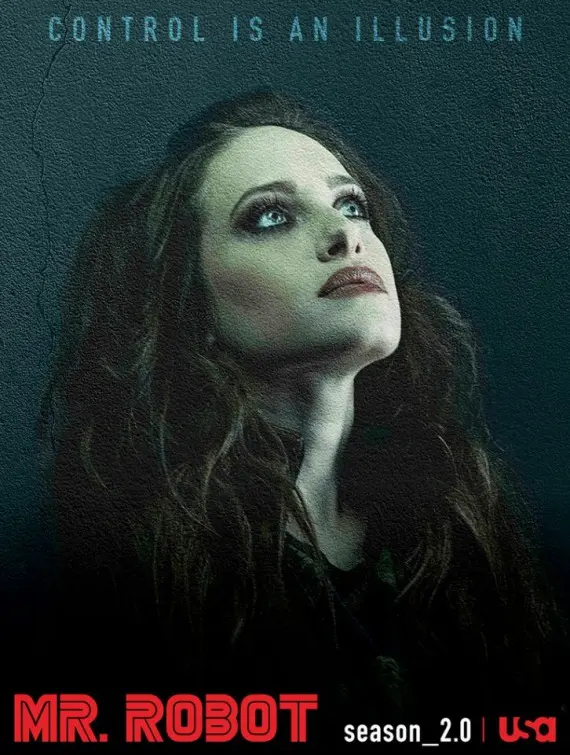
Darlene Alderson: Generalissima
Angela, now climbing for power at E-Corp marvels at the edge she will walk to use the hackers’ tools to advance her rise in the corporation. A woman whose husband has disappears calculates her revenge and guards her vulnerability. The characters caught in this grand moment are put on display, typically performing for themselves or us. Grand action and picaresque schemes of derring-do are very much lacking.
In this, “Mr. Robot” recalls “The Prisoner.” Were each episode an example of the hackers staying one step ahead – or behind – the show would devolve to something like “Batman,” “Wild, Wild West,” or “Kung-Fu”: yet another entry in the long tradition started with the tales of knights errant and courtly love. “Mr. Robot” creator Sam Esmail recalls “The Prisoner” creator Patrick McGoohan in having the deeper insight that ultimately the shows will devolve into “Batman” episodes unless new frontiers of conflict are explored. The most rich and fecund fields for exploration are those involving protagonist against self, against society, or institutions.
For those who were tuning in for hacker-“Batman,” the show must have been confusing and disappointing. However, for those who are willing to go on the deeper voyage, to have even more systems of control analyzed, targeted, and vivisected, “Mr. Robot’s” second season offers promise and even teases the question: “If you knew what all the effects would be, would you roll it back? Would you give the Hydra back its head for the peace of predicatbility?” Or, more sinisterly, “Do you have the (possibly sociopathic) need to go all the way even after having seen a portion of the human cost?”
It’s the Miltonian question Esmail has lain before us as we await Season 3.